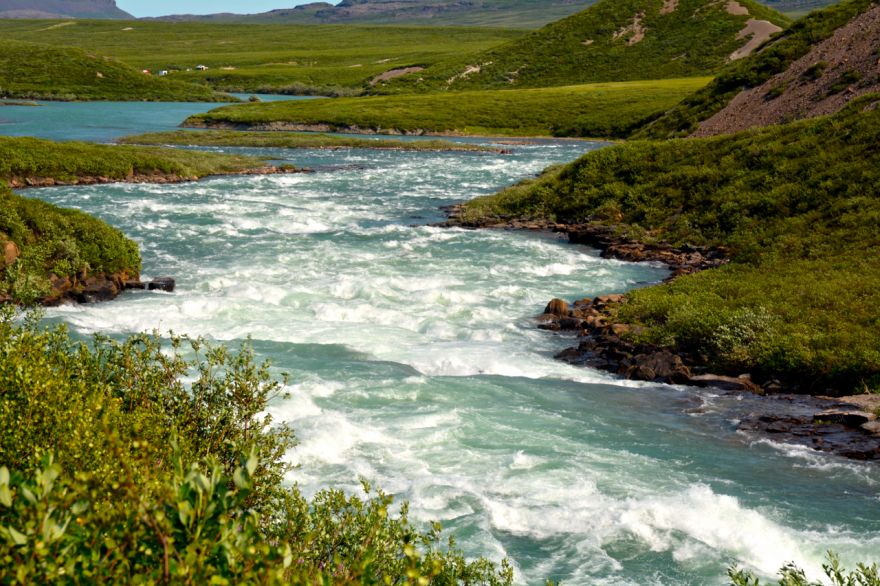Tree River Fly Fishing: Approaches and Tactics
 Written by
Josh “Jelly” Gelinas
Written by
Josh “Jelly” Gelinas
- Published in Fly Fishing the Bear
- Read 11954 times
- font size decrease font size increase font size
The Tree River is one of the most famous Arctic Char fisheries on the planet.
While the river itself is relatively long, we only fish about a 6km section.
Our portion of the river starts with a rather large waterfall that tumbles in a series of class 4/5 rapids. At the base of these rapids, it then widens out into a small “lake like” basin. There is another substantial rapid at the tail end of the basin, followed by several more kms of fishable water, where it then empties its teal coloured waters into the Arctic Ocean.
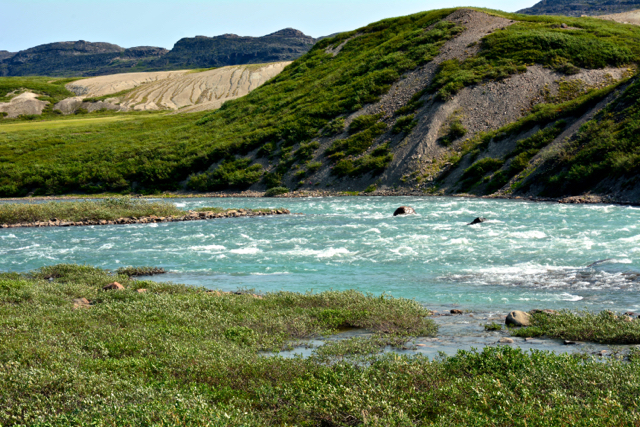
The Char runs are small but frequent, and the approach to each wave of fish is surprisingly different from one to another, based in large part on the time of year, and water levels.
Success none the less can be found everywhere, provided you’re on the right line/leader combination, and using the right fly in relation to the conditions on the river.
But unlike most fly - fishing, especially for Char, the fish we catch get very large. They average 10-18 lb., which is a much larger than what you will find in virtually any other river in the world, and is where the current World Record Char, which stands at 32 lbs. 9 oz. was caught.
These fish tend to get squirrelly, and use the fast water to their advantage. So let me tell you from experience, in order to catch and land one of these incredible fish, an individual has to understand just how advanced and challenging this river is.
I hope this article will help explain how to approach the river, and better prepare anyone looking for that fly fishing trip of a lifetime to be more mentally and physically prepared for the legendary Tree River Arctic Char.
About Me…
But before we get into it, let me introduce myself.
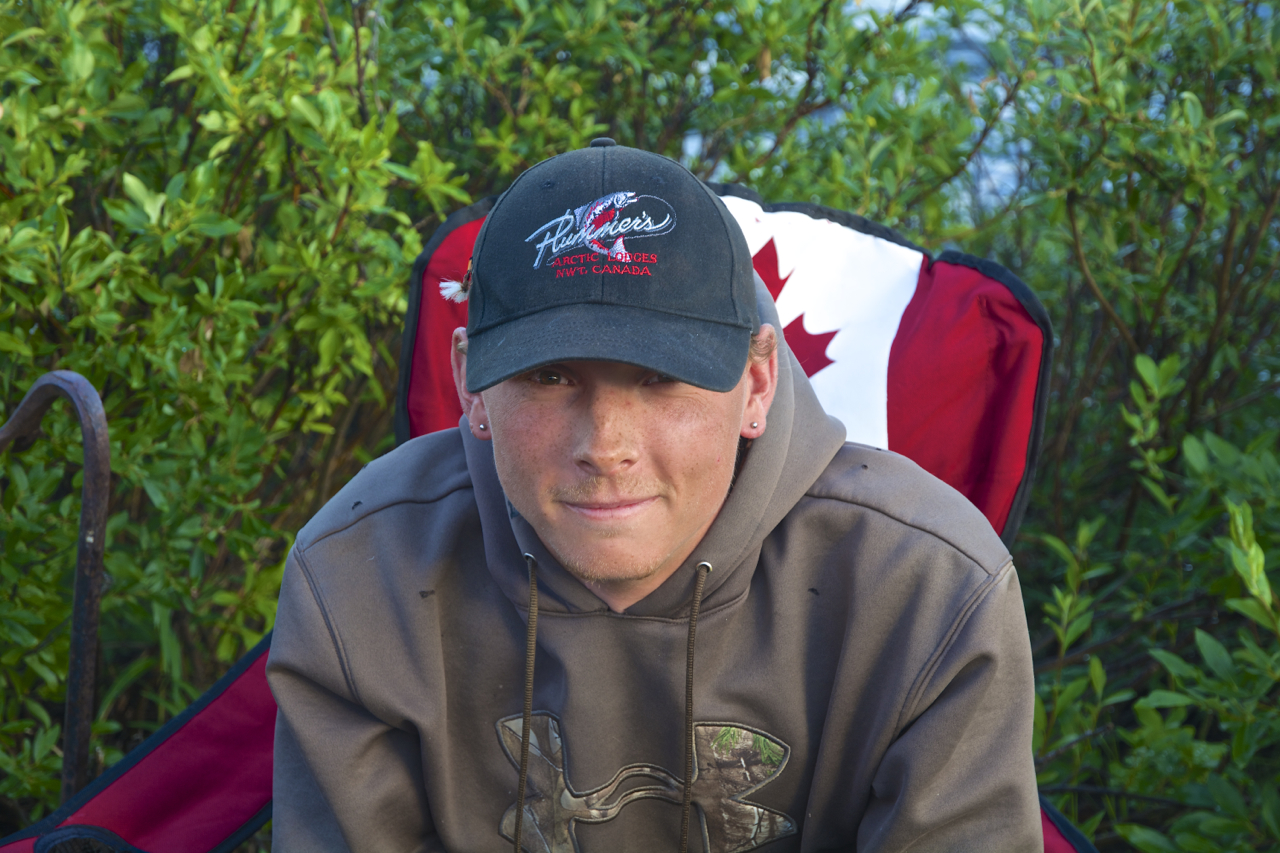
My name is Josh Gelinas, but most people call me “Jelly.” I’ve been a guide on the Tree River for the past three seasons, and have been both humbled and amazed by it many times.
I’m a competitive angler at heart, who has had the opportunity to fish many diverse bodies of water both internationally, and throughout Canada, and I’d have to say that my time on the Tree River has easily proven to be the most challenging for me - especially as the guide - to maintain consistent success with my guests on a week-to-week basis.
The river changes so fast, and after learning from some of the most seasoned guides in the north, I have come to realize that consistency comes to those who understand the patience and tactics necessary to have one of those legendary days on the Tree.
Look at every pool on the river as a blank page - an empty slate.
Forget everything you learned at the last pool, and the four pools before that, and focus on a new approach, because a lot of our pools vary drastically from each other.
We have good fast Spey runs, incredible crystal clear back eddies, and side eddies the size of a bathtub that almost always will hold Char.
I’m lucky enough to have had many good days on the Tree (along with harder ones) and am now confident enough in saying I’m comfortable guiding anyone on the Tree.
This fabulous river has shown me multiple tippet records, days with outstanding numbers, and days with huge fish.
In this article I want to share the knowledge I’ve gained over the last three years broken down into early season, mid season, late spawn season fishing, water levels and Char behaviour.
Early Season
Early season can be best described as a time of fly-fishing carnage.
Generally the first 3 weeks of the season the success rate is incredible.
Fresh fish pushing up daily make for good number days (with large ones that show up from time to time) that scrap like crazy, and can generally be easily caught with both conventional spinning/casting gear using spoons, or any large, bright streamer pattern.
The rule of thumb, and the rumour I’ve always heard from people with experience, has been that Arctic char fish very similar to Steelhead.
This is true to an extent, but mainly for the brightly coloured Salmon Popsicles and Zonker variants such as Squidros, Muddy Buddy’s and Dahlia Llamas used as popular Char and Steelhead flies alike.
My opinion, and the one I stand by, is that this tactic only works in the spring, or in the case of the Tree – early summer.
Not to say it wouldn’t work in mid to late season as it often does, but I find there are other methods and approaches available that prove more efficient fish catchers than the super intrusive steelhead streamers people get stuck on.
In early season though, bright and big is the way to go.
Pinks, Purples, Blues, Whites, Chartreuses and Oranges are the best colours in my view, with a size 4- 2/0 on a GOOD SALMON HOOK, because strong hooks are essential, especially in the early season where the char hit like freight trains.
I use a Hardy Jet 7 weight, but I’m also insane in that sense.
What I would suggest is a comfortable 9-10 ft., 8-10 weight with a floating line, and another float line with a fast sink tip (Di 5+).
For leader material I generally create my own. I don’t use tapered anything for any Tree River scenario, and generally run 6-10 ft. (based on aggression levels and water clarity) of P-Line Halo 20lb test.
Early season the fish aren’t coloured up. No red tomato Char cruising the river generally until late 3rd week, where even then you just see the start of sparse colouration in the fins and belly of males.
If your not necessarily looking for your red male Char photo, this is the time to visit the tree.
I’ve had 12-20 fish days on the river when the conditions are good, and a fresh push has made it to a few of the pools. All chromed up fish that are very aggressive and active.
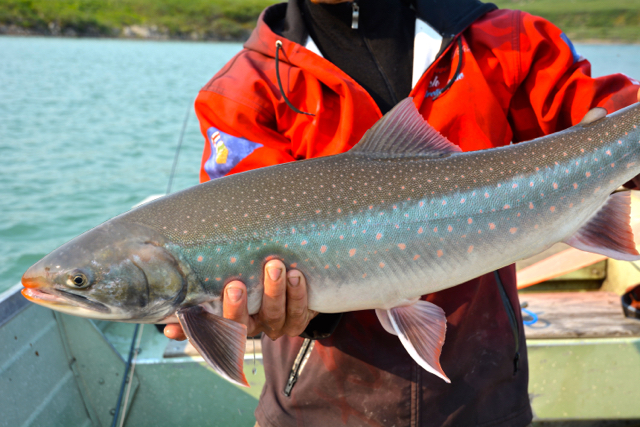
Most of the river at this point is productive, other than perhaps the pools and runs higher upstream, because the majority of the fish haven’t made it up that far as yet.
Mid Season
Mid season is a rookie guides worst nightmare, because this is when fish behaviour, and conditions on the river change drastically.
The fish at this point start to show colour, but not quite the hard-core tomato red colour. You will see a lot of orange bellies and red fins though.
Unfortunately, with all migratory fish this is when spawning starts, and the famous saying is at this point the fish: “Are more horny than hungry.”
The same tactics from early season will still work, but are nowhere near as productive as they were during the first couple of weeks.
My general approach at this point in the season is switching to non-intrusive colours. Browns, whites, blacks, and olive Zonkers, Intruders or Popsicles are my go to at this time of season.
This is the time of season where the water levels tend to vary significantly. The river drops and rises fast, which can change a lot of things regarding leader and fly setup.
Late Season
This can be the most challenging portion of the season, because almost everything that worked in the early season is least effective, and a lot of the time many guests will fight just to find one fish.
There are secrets for getting on fish during this part of the season though, and what I would suggest is to take the tactic I’m about to describe, and practice in order to work out the kinks, before tackling the Tree.
What I found were the best tactics for catching fish at this time of the year was by working egg patterns under an indicator, or using the “hopper dropper” style leader system.
During late season, we had started plugging beads hard, and fished egg patterns under the indicator, and we were successful on almost every pool on the river.
Orange or pink used in a dead drift, and sight casting any of the big red males you see piled up in the pools worked very well.
Another event that happened this year was my first guided char landed on a dry fly!
In Presidential Pool the water was incredibly low come the 8th week. All of the fish in the pool were clearly visible, and based on their behaviour, very spooky.
We started with the egg patterns, and what we found was that the indicator was spooking the fish. I suggested to my guest that if they had a Foam Hopper or Adult Stonefly pattern to use it instead, because it would be a less intrusive approach while utilizing the same tactic.
Sure as hell, on my guests’ first cast we land an 8lb female off the surface, with the adult stonefly firmly embedded in the corner of the fish’s mouth.
If you plan to visit the Tree River in the last two weeks of the season the fact is, the fishing is amongst the most challenging Canada has to offer.
To catch one of the big red tomato Char is very exciting, and for many anglers, a once in a lifetime experience.
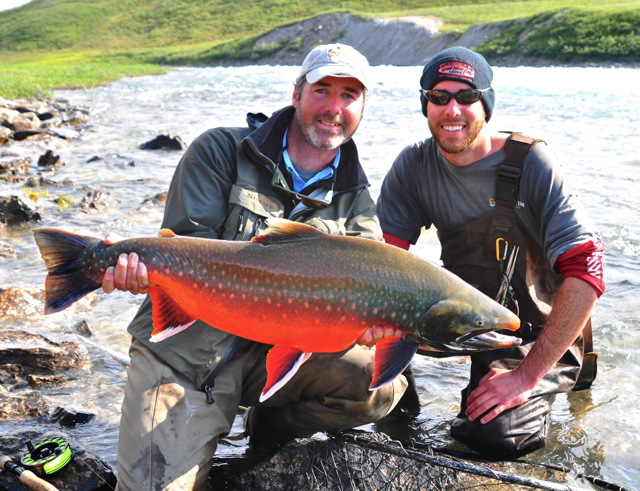
During late season, stick to low water tactics, and start with plugging beads and sight casting in the upstream portion of the river. If that doesn’t work, try using a smaller, non-intrusive Bugger or Zonker pattern (brown, white or black), and for egg colours, I’d start with orange and pink.
WATER LEVELS
High Water
Use a sink tip line (DI 5+) and a heavily weighted streamer similar to the ones I mentioned above. Tungsten heads and a few lead wraps go a long way.
I personally (depending on the pool or run) will go with a 6-12ft leader of Pline Halo 20lb flouro. Swinging flies will be fast in most situations.
Where the water is fast and deep, minimizing the leader will allow the weight of the fly to work its magic with help from the fly line as well.
Short casts and constant mending is required to keep in touch with the fly. Use a 6-8 ft. leader in these situations, because it will make it easier to keep in touch with what’s happening with the fly.
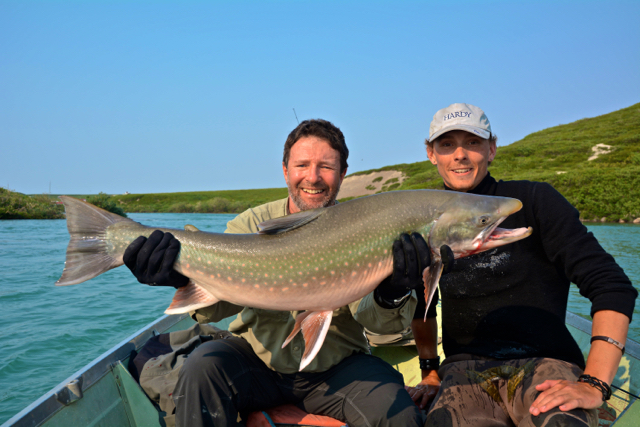
For pools such as Presidential, and anywhere downstream, the current is slower, and although even in high water there’s a noticeable difference in flow rates, the depth doesn’t change drastically, and an 8-12 ft. leader is preferable in these spots.
Low Water
Low water conditions such as the ones we faced for the majority of the 2016 season are almost preferable.
The Char are less dispersed, and you can generally sight cast to them at many of our famous pools.
Use the same flies I mentioned above, but this time use a much longer leader, and use partially weighted or unweighted flies.
For the entire river (with the exception of much deeper spots such as the pool directly below second falls on both sides) I will generally us a 10-14ft leader. For the deep - water spots, switch to a heavier fly and shorten leader, and DON’T FORGET TO STRIP THROUGH THE SWING!
With less heavy flow, the char that are hungry are prone to chase any big streamer moving erratically through the water.
Don’t get discouraged by fish that won’t bat an eye at the fly. Even though you can clearly see the Char, chances are it spotted you even before you started fishing.
These fish are easy to spook, and while it’s not always obvious just how spooked they really are, they simply won’t show any interest, regardless of what you throw at them.
Stay patient, quite and low.
In Conclusion…
All In all, I hope this article will be helpful to anyone who has either been, or is planning on going to the Tree River.
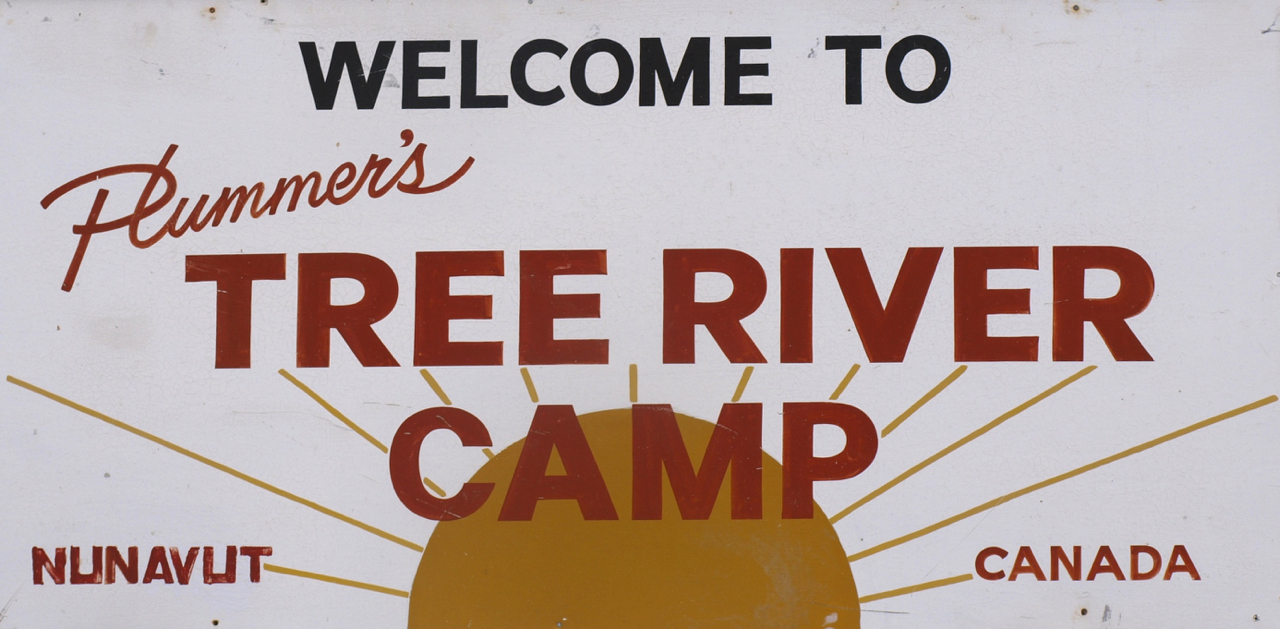
The Tree is a magical place that coughs up some of the most stunning fish on earth, and it is truly a paradise for any ambitious fly fisherman.
It’s an honour and privilege to be guiding on such a river, and just being there and experiencing it, is something I’ll never take for granted.
To all future, and returning guests, tight lines fishing, and best of luck on your trip to the Tree River!
Josh “Jelly” Gelinas
Btw: If you have any questions about this article, or fly fishing the Tree River in general, please feel free to contact me via this site, and I will do my best to answer them.

